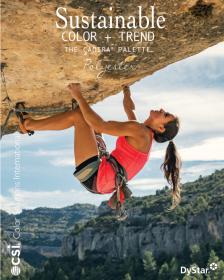Oerlikon Neumag at Domotex Asia 2018
The market for the production of carpet yarn is increasingly evolving towards more demanding processes. However, beyond commodity products, standard plants can no longer fully exploit their advantages. From 20th to 22nd March 2018, Oerlikon Neumag will be presenting an economical alternative in Shanghai in hall W3, booth F03 at the Domotex asia/Chinafloor, the leading floor covering trade fair in the Asia-Pacific region: the BCF plant Sytec One with single-end technology.
If the requirements for the production of BCF yarns increase, for example, from recycled polyester or fine filaments, then this can also lead to higher breakage rates. Highly standardised production plants must then often strike compromises with regard to throughput, quality or cost-efficiency. In such cases, the Sytec One offers a good solution instead of the mostly three-end technology plants for standard processes.
Single-end technology with 98% productivity
This BCF plant works with only one yarn (end) per position, making it ideal for demanding production processes. The reason: when a yarn break occurs only one yarn tears, all other yarns continue to run. This not only simplifies troubleshooting, it also reduces the re-threading time. In addition, less waste is produced. As a result, the productivity of the Sytec One is still over 98% for ten breakages a day, while a plant with three-end technology only reaches around 92%.
Faster processes due to a straight yarn path
In addition, the absolutely straight yarn path of the Sytec One enables significantly higher process speeds of up to 15% in spinning and texturing processes compared to multi-end technologies. Higher total titers of up to 6,000 dtex can also be produced without any problems. The gentle yarn guidance also ensures minimum friction on the individual filaments. This means less yarn breaks and a more stable process.
Optimised key component: spinning pack
Last but not least, the engineers at Oerlikon Neumag have developed a new design for the spinning pack. This central component of every BCF machine significantly influences the yarn quality. The corresponding solution for the Sytec One optimises the polymer flow in the spin pack, thus reducing the polymer dwell time. This leads to shorter product and colour change times and increases the plant efficiency. In addition, the spinning packs were widened so that yarns with up to 500 filaments can now be produced.
The product mix is decisive
In view of these advantages, the single-end Sytec One is recommended for processes with high breakage rates, fine filaments, frequent colour changes or in general when demanding processes take up an increasing share in the business. "The product mix is decisive for the choice of technology," sums up Alfred Czaplinski, Sales Manager BCF at Oerlikon Neumag. "We are happy to advise on the optimal solution and offer both single-end and three-end plant technologies."
Good business at the Domotex Hanover, Germany
In the run-up to the trade fair, the Domotex Hanover in mid-January was already proving to be a promising harbinger. With four lively trade fair days and contract conclusions in the lower double-digit million euro range, mainly from the European and Asian markets, the order intake for Oerlikon Neumag was very good.
Oerlikon Textile GmbH & Co. KG










